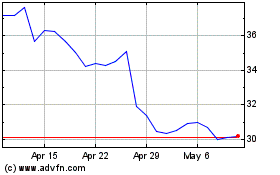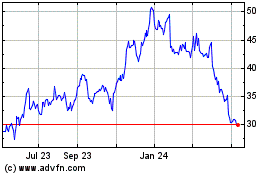By Ese Erheriene
Watchmakers, caught off guard by the success of Apple Inc.'s
smartwatch, are now trying to keep pace with changing customer
tastes by introducing messaging alerts and other high-tech features
to traditional watches.
Brands including TAG Heuer, Swatch and Fossil Group are working
with Apple rivals such as Alphabet Inc.'s Google and Intel Corp. to
offer their own smartwatches or hybrid versions that offer smart
functions while retaining traditional design.
Global shipments of Swiss watches steadily slipped after the
first Apple Watch was unveiled in 2015, a dip compounded by a slump
in China sales. Despite picking up in the past two years, they were
overtaken last holiday season by Apple's smartwatch for the first
time. UBS predicts Apple Watch sales will rise 40% next year to
reach 33 million. The tech giant is expected to move 8.8 million
shipments in the fourth quarter of this year, said Francisco
Jeronimo, a research director at International Data
Corporation.
"The global watch market has had a shock and it worries us,"
Daeboong Kim, head of South Korea's Watch & Clock Industry
Cooperative, said in an interview at the world's biggest industry
fair in Hong Kong in September. The cooperative is getting advice
from Samsung Electronics Co., the world's biggest smartphone maker,
to help members develop watches with smart functions. Samsung and
Apple declined to comment.
Sales of smartwatches overtook mechanical watches in 2016 while
hybrid-watch sales rose to 7.5 million world-wide in 2017 from
almost nothing in 2015 according to market-research firm
Euromonitor International. Sales volumes for both watch types are
set to double by 2020, it predicts.
The digital divide is growing, however, as the Apple Watch
Series 4 released last month added an alert system for when the
wearer falls down and a function designed to identify heart
irregularities. Analysts say those features target a demographic of
faithful watch buyers who are typically more resistant to
technology: older customers.
While some traditional watchmakers have tried to move into
smartwatches, many have focused on hybrids. Typically, these don't
have touch-screens. Instead, they are synced with smartphones via
an app and alert the wearer to messages or calls through
vibrations, blinking lights or by moving the watch's hands. Via
Bluetooth connection, users push buttons on the watch to control
the phone's camera and music functions.
TAG Heuer is one of the higher-end brands fighting back,
releasing an upgrade of its smartwatch, the Connected Modular 41,
earlier this year. The watch is the result of collaboration with
Intel and Google. It has fitness tracking, GPS, and contactless
payment.
Jean-Claude Biver, TAG Heuer's chief executive, said its hybrid
is having success because "it really looks and feels like a real
watch, but with all the information you need." TAG Heuer is owned
by LVMH Moët Hennessy Louis Vuitton SE, which declined to disclose
sales figures.
TAG Heuer's lowest-priced Connected Modular 41 sells from around
$1,200. While luxury watchmakers are least affected by Apple's
competition, more luxury Swiss watch brands are researching hybrid
watches as a gateway to full smartwatches, IDC's Mr. Jeronimo
said.
Fellow luxury Swiss brand Hublot is focusing on limited-edition
devices with commercial partners. It released 2,018 pieces of the
"Big Bang Referee" smartwatch for the 2018 soccer World Cup that
featured in-game alerts and envisages watches connected to luxury
sports cars that flag performance data and open doors.
"We must bring something different than what exists. We are not
competing with Apple," said chief executive Ricardo Guadalupe.
Swiss watchmakers that operate in a price category similar to
Apple--the Series 4 starts at $399--are feeling the pain of Apple's
competition, with the number of loss-making companies in the low to
midrange market rising, according to the Federation of the Swiss
Watch Industry.
Richardson, Texas-based watchmaker Fossil Group, which also
operates under other brand names, dominates the global hybrid-watch
market, selling one in three globally. The group released about 25
new smartwatches this year for brands including Emporio Armani and
Diesel. Functions include heart-rate monitoring and Google Pay
technology.
Fossil executives thought the watches would appeal to younger
buyers, but mature watch buyers are also showing interest, said
Greg McKelvey, who heads the group's digital strategy.
Fossil Group's Q Modern Pursuit hybrid, which sells for around
$155, is one of the more affordable smartwatches.
Swatch Group, one of the biggest publicly listed watchmakers,
released its latest watch featuring some smart technology in
2017--the Swatch Bellamy 2 which enabled users to make contactless
payments. It said last year it plans to develop its own operating
system for watches, dubbed Swatch OS, and launch the first products
using it by the end of this year or next.
This isn't the first time Switzerland's centuries-old
watchmaking industry has faced a threat from technology. The rise
of cheaper, more-efficient quartz watches from Japan in the 1970s
similarly hit Swiss watchmakers' sales.
Not all watchmakers plan to compete. Developing hybrid watches
isn't an option in our price range of $170 to $570, said Thomas
Swiderski, director at family-run Swiss watchmaker Adriatica. "You
can't fight with Apple or Samsung, because we'd make something
similar but not as good. We have no chance."
Write to Ese Erheriene at ese.erheriene@wsj.com
(END) Dow Jones Newswires
November 17, 2018 07:14 ET (12:14 GMT)
Copyright (c) 2018 Dow Jones & Company, Inc.
Intel (NASDAQ:INTC)
Historical Stock Chart
From Mar 2024 to Apr 2024

Intel (NASDAQ:INTC)
Historical Stock Chart
From Apr 2023 to Apr 2024
